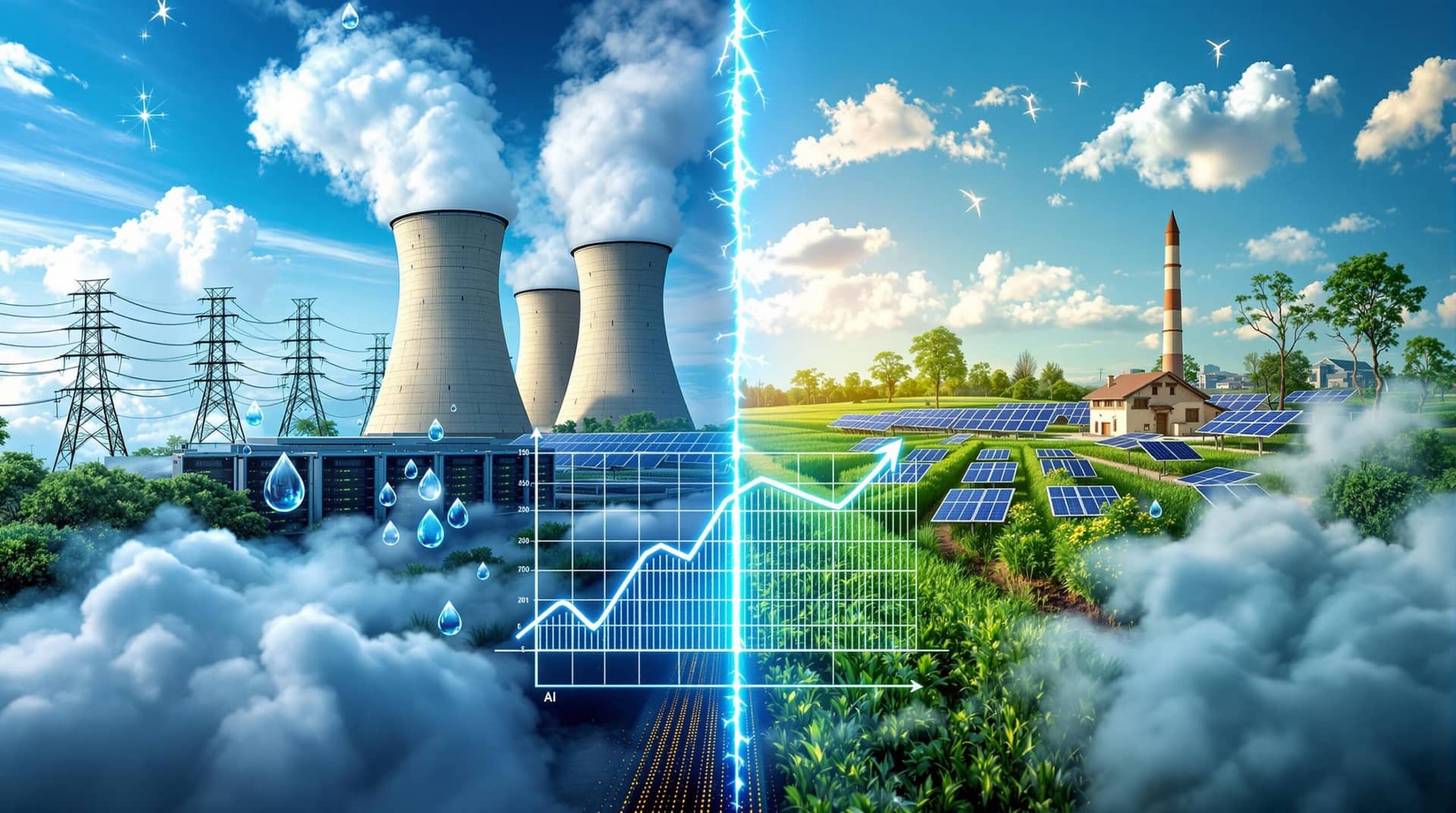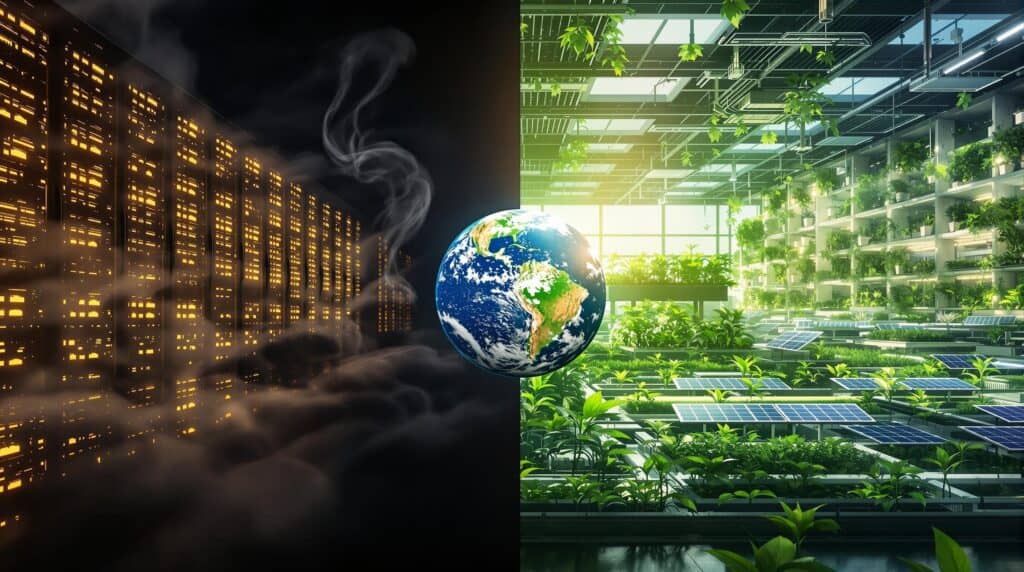According to a 2021 research study published in Joule, training a single large AI model can emit as much carbon as five cars during their entire lifetimes, highlighting the urgent need for eco-friendly technologies for sustainable living in our increasingly AI-driven world. The environmental footprint of artificial intelligence is growing exponentially as these technologies become embedded in our daily lives, making the development of eco-friendly technologies for sustainable living a critical priority for responsible technological advancement.
Key Takeaways
- AI model training consumes massive amounts of energy – a single large model can use 1,300 megawatt-hours of electricity
- Implementation of eco-friendly technologies for sustainable living can reduce AI’s carbon footprint by up to 50%
- AI itself is being applied to enhance sustainability efforts across sectors including agriculture, energy management, and conservation
- The AI industry faces significant water consumption challenges, with major models requiring hundreds of thousands of liters for cooling
- Both technological innovation and regulation are needed to balance AI advancement with environmental protection
The Energy Hunger of Artificial Intelligence
The rapid expansion of AI technology comes with a substantial energy cost. According to World Economic Forum projections, AI energy consumption will reach a staggering 134 TWh by 2027 – exceeding the annual electricity usage of entire countries like Belgium. This energy demand translates to approximately 4.32 grams of CO₂e per AI query, accumulating to massive carbon emissions as usage scales.
Data centers powering AI systems have become increasingly power-hungry, with many still reliant on fossil fuels despite commitments to renewable energy. The environmental impact is particularly concerning as AI adoption accelerates across industries, with generative AI applications dramatically increasing computational demands.
The energy requirements of large language models (LLMs) demonstrate this challenge clearly. Training GPT-3 consumed 1,300 megawatt-hours of electricity—equivalent to the annual power consumption of 130 U.S. households. Each new generation of AI models typically requires exponentially more computing power than its predecessor, creating an unsustainable trajectory without intervention through eco-friendly technologies for sustainable living.

Water Consumption: AI’s Thirst for Resources
Beyond electricity, AI development creates another environmental challenge: excessive water consumption. Data centers require enormous amounts of water for cooling their systems. According to research from The Cool Down, training GPT-3 required approximately 700,000 liters of freshwater for cooling processes alone.
Major tech companies demonstrate this water-intensive reality. Microsoft’s data centers consume approximately 11.5 million gallons of water annually to maintain optimal operating temperatures. This creates particular tensions in drought-prone regions like Arizona and Chile, where water scarcity already impacts local communities.
The conflict between AI advancement and water conservation represents a growing challenge for eco-friendly technologies for sustainable living. As AI models grow in size and complexity, their cooling requirements increase proportionally, creating a sustainability paradox that demands innovative solutions.
Eco-Friendly Technologies for Sustainable Living Through Green AI Frameworks
The GreenAI Institute has developed comprehensive frameworks for addressing AI’s environmental impacts. Their four-pillar approach to sustainability in AI development provides a roadmap for reducing resource consumption while maintaining technological advancement.
These frameworks emphasize measuring environmental impacts, optimizing models for efficiency, utilizing renewable energy sources, and developing innovative cooling solutions. By implementing these strategies, companies can significantly reduce the ecological footprint of their AI initiatives while still delivering valuable capabilities.
Model Optimization Techniques for Eco-Friendly Technologies for Sustainable Living
Neural architecture search represents one of the most promising approaches for creating more efficient AI systems. By automatically discovering optimal model architectures, this technique has demonstrated energy reductions of up to 50% while maintaining performance levels. Model compression strategies further enhance efficiency by reducing parameter counts and computational requirements.
Small Language Models (SLMs) offer a particularly promising direction for sustainable AI development. These compact alternatives to massive LLMs can achieve comparable performance on many tasks while using just 1/10th of the energy. As noted in a recent study in the Proceedings of the National Academy of Sciences, specialized models designed for specific tasks often outperform general-purpose models while using substantially fewer resources.
Energy-Efficient Infrastructure Solutions
Google DeepMind has pioneered AI-powered cooling optimization that reduced data center energy usage by 40%. This represents a powerful example of using AI to improve its own sustainability. Renewable-powered data centers utilizing solar, wind, and emerging hydrogen fuel cell technologies offer additional pathways toward carbon neutrality.
Hardware innovations also play a crucial role in creating eco-friendly technologies for sustainable living. NVIDIA’s H100 GPUs deliver significantly better performance-per-watt compared to previous generations, while quantum computing prototypes show promise for certain AI workloads with dramatically lower energy requirements.
Water conservation efforts include closed-loop cooling systems that recycle water and air-cooled alternatives that eliminate water consumption entirely. These innovations are critical for areas facing water scarcity issues where traditional data center cooling approaches are unsustainable.
Eco-Friendly Technologies for Sustainable Living: AI Applications
While AI development presents environmental challenges, the technology itself powers numerous responsible sustainability solutions across sectors. This dual nature of AI – both environmental challenge and solution – demonstrates the importance of thoughtful implementation.
Smart Resource Management Applications
Precision agriculture systems powered by AI have reduced water usage by 16% while simultaneously increasing crop yields. These systems optimize irrigation, fertilization, and harvesting based on real-time conditions, reducing waste and environmental impact.
Smart grid technologies leverage AI to integrate renewable energy sources and reduce waste by 20-30%. The complex balancing of energy supply and demand benefits tremendously from AI optimization, enabling greater renewable penetration and grid stability.
Carbon capture technologies enhanced by AI algorithms are sequestering approximately 4,000 tons of CO₂ annually in pilot projects. By optimizing capture conditions and processes, AI helps make these critical climate technologies more efficient and economically viable.
Transportation systems like Tesla Autopilot reduce vehicle energy consumption by 15% through optimized driving patterns. When scaled across millions of vehicles, these efficiency gains translate to significant carbon reductions.
Environmental Monitoring and Protection
IBM’s Green Horizon Project demonstrates AI’s potential for environmental monitoring, predicting air quality with 90% accuracy to help cities implement targeted pollution reduction strategies. Similar systems track forest health, ocean conditions, and biodiversity indicators to support conservation efforts.
Climate modeling has made tremendous advances thanks to AI techniques that can process vast datasets and identify subtle patterns. These models help scientists and policymakers better understand climate dynamics and potential mitigation strategies.
Biodiversity protection efforts are enhanced through AI-powered monitoring systems that can detect illegal logging, poaching, and changes in ecosystem health. These systems extend the reach of conservation organizations by automating surveillance across vast areas.
Challenges and Roadblocks to Eco-Friendly Technologies for Sustainable Living in AI
Despite promising developments, significant obstacles remain in making AI truly sustainable. E-waste generation represents a growing challenge, with approximately 53 million metric tons produced globally each year. The rapid obsolescence of AI hardware contributes substantially to this waste stream.
Transparency issues in resource usage reporting make it difficult to accurately assess environmental impacts. Many companies do not disclose comprehensive information about their AI systems’ energy consumption, water usage, or carbon emissions, complicating efforts to establish industry-wide standards.
Environmental justice concerns arise for communities near data centers, which may face water shortages, pollution, or other negative externalities without sharing in the economic benefits. These social equity dimensions of AI development require careful consideration alongside technical solutions.
Corporate Responsibility and Regulatory Approaches
Carbon-aware computing strategies represent a promising corporate response to these challenges. By scheduling intensive computational tasks during periods of low grid carbon intensity, companies can reduce emissions without sacrificing performance.
The EU’s Artificial Intelligence Act mandates efficiency disclosures for AI systems, establishing a regulatory framework that encourages sustainability. Similar regulations are being considered in other jurisdictions, potentially creating global standards for environmentally responsible AI development.
The GreenAI Institute has developed benchmarks for standardized reporting of AI environmental impacts, giving developers and users consistent metrics for comparison. These tools help integrate sustainability considerations into AI selection and development processes.
Environmental justice assessments are becoming an important component of data center planning, with companies increasingly engaging with local communities to address concerns and ensure fair distribution of benefits and burdens.
The Future of Eco-Friendly Technologies for Sustainable Living in AI Development
The future trajectory of AI sustainability shows promising trends toward more efficient models designed with environmental considerations from the outset. As noted in Harvard Business Review research, companies are increasingly recognizing that efficiency and performance need not be trade-offs.
Integration of AI in renewable energy expansion represents a particularly promising synergy. AI systems can optimize renewable deployment, manage complex grids with high renewable penetration, and accelerate clean energy research and development.
Balancing technological progress with environmental stewardship will require ongoing collaboration between technologists, environmental scientists, policymakers, and communities. This holistic approach recognizes that technical solutions alone cannot address the complex sustainability challenges posed by AI.
For consumers, developers, and policymakers, taking action means demanding transparency, supporting efficient AI approaches, and developing appropriate regulations. By making sustainability a core requirement rather than an afterthought, we can ensure that AI delivers its promised benefits without unsustainable environmental costs.
The development of eco-friendly technologies for sustainable living will be crucial in ensuring that AI becomes a net positive for our environment rather than another source of ecological strain. Through thoughtful innovation and application of ethical AI principles, we can harness these powerful technologies while preserving our planet’s resources for future generations.
Frequently Asked Questions
How much energy does AI training really consume?
Training a single large AI model like GPT-3 consumes approximately 1,300 megawatt-hours of electricity, equivalent to the annual power usage of 130 American households. The energy footprint increases substantially with larger models, with some estimates suggesting that training the largest models can emit as much carbon as five cars during their entire lifetimes.
What are the most promising eco-friendly technologies for sustainable living in AI development?
The most promising approaches include neural architecture search (reducing energy needs by up to 50%), specialized Small Language Models that use 1/10th the resources of large models, renewable-powered data centers, and AI-optimized cooling systems like those pioneered by Google DeepMind, which have reduced cooling energy by 40%.
How much water do AI systems consume?
Water consumption for AI systems is substantial, primarily for cooling data centers. Training GPT-3 required approximately 700,000 liters of freshwater, while major tech companies’ data centers consume millions of gallons annually. This consumption creates particular challenges in drought-prone regions where water resources are already stressed.
How is AI being used to advance eco-friendly technologies for sustainable living?
AI is enhancing sustainability through precision agriculture (reducing water usage by 16%), smart grid optimization (increasing renewable integration by 20-30%), carbon capture optimization, efficient transportation systems like Tesla Autopilot (reducing energy by 15%), and environmental monitoring systems that can predict air quality with 90% accuracy.
What regulations exist for AI’s environmental impact?
The EU’s Artificial Intelligence Act includes provisions for efficiency disclosures, while various voluntary frameworks like those from the GreenAI Institute provide standardized reporting metrics. Regulations are still developing, with growing emphasis on transparency regarding energy usage, emissions, and water consumption associated with AI systems.
How can consumers support eco-friendly technologies for sustainable living in AI?
Consumers can support sustainable AI by choosing services that disclose their environmental impacts, using energy-efficient devices, limiting unnecessary AI queries that consume resources, supporting companies that commit to renewable energy for their data centers, and advocating for regulations that require transparency about AI’s ecological footprint.
Sources:
Harvard Business Review – The Uneven Distribution of AI’s Environmental Impacts
CII Blog – The Role of Technology in Sustainable Living
World Economic Forum – Generative AI Energy Emissions
Industry Science – Aiming to Create Green AI
The Cool Down – Artificial Intelligence Energy Demand Tech Pollution
2030 Builders – 8 Ways AI Can Contribute to Environmental Conservation
Arbor Eco – AI Environmental Impact
Lead The Change (Bard Education) – AI’s Environmental Impact vs. Its Role in Advancing Jobs in Sustainability
Green AI Institute – Research
Robotics Tomorrow – Trend 2025: Energy Requirements Often Depend on the Size of the AI Model
Caltech – What is Sustainable AI: Significance & Examples
Harvard Astrophysics Data System
World Economic Forum – AI Energy Dilemma: Challenges, Opportunities, and Path Forward
PMC (PubMed Central)




